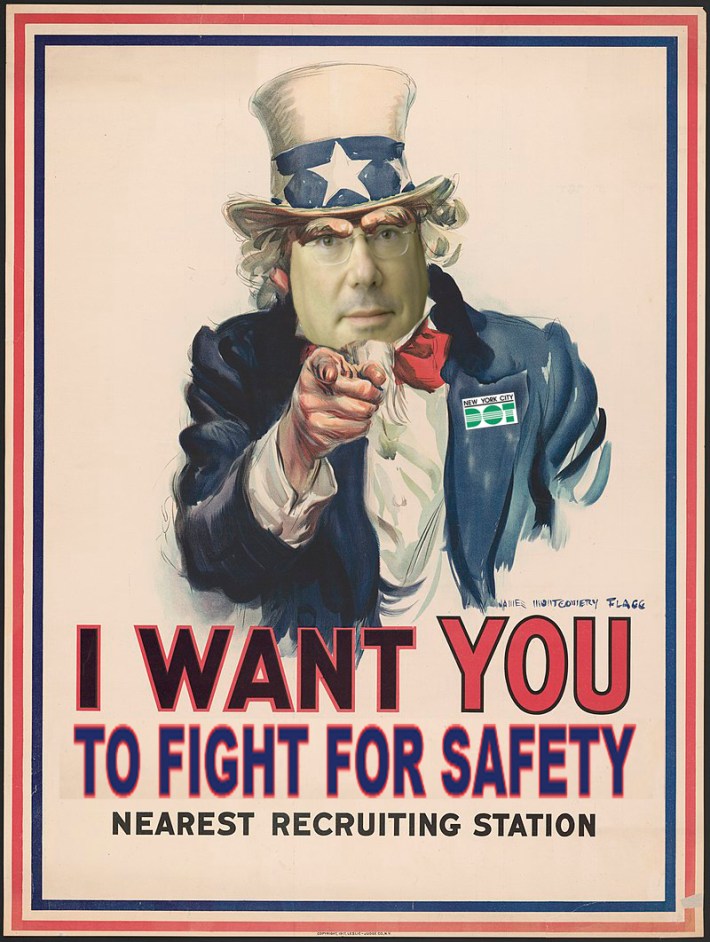Here’s Your Big Chance To Guide The Streets Master Plan
12:01 AM EDT on July 7, 2021

Apologies to: James Montgomery Flagg
Uncle DOT wants YOU.
The Department of Transportation is seeking the public's help to finally craft the Streets Master Plan, a City Council-mandated blueprint for how the city will carry out a 2019 law requiring the installation of 250 miles of bike lanes, 150 miles of bus lanes and one million square feet of pedestrian space every five years. But master plans don't come from nowhere, so the DOT is asking city residents to attend online workshops and complete a survey of local traffic or safety hotspots.
Advocates say that the Streets Master Plan could help replace the current, broken process under which every single street safety initiative (however minor) is endlessly debated at the community board level and some are scuttled due to "community" "concerns." Rather, if done correctly, the Streets Master Plan could force community boards to play only a positive role because the outcome — 250 miles of bike lanes, 150 miles of bus lanes, etc — is now pre-determined by city law.
"We need the community boards [and] all the different constituencies in the room for the streets master plan so that we don't have a bunch of shocked looks on people's faces when the DOT says, 'Time to put in this segment of the bike network,'" said Bike New York Director of Advocacy Jon Orcutt. "We should use the community boards for things like, 'Did you consider this business loads in x tonnage of deliveries each week on this spot, so there should be a loading dock.' That's the kind of stuff you want them to point out."
Hey New Yorkers! We need your help! NYC DOT is working to improve the places you walk, bike, ride the bus, and spend time with loved ones.
— NYC DOT (@NYC_DOT) June 28, 2021
Head over to our online portal to give us your ideas: https://t.co/L90n7nuKXJ #NYCStreetsPlan pic.twitter.com/O5E4bC2Vm7
The DOT did not respond to a request for comment on what the workshops would involve, but a source familiar with the process said that there would be breakout rooms guided by agency employees looking to hear feedback on neighborhood transportation issues. Such a process has long been commandeered by the loudest anti-cycling or pro-parking voices in the room, but the breakout rooms and facilitated environment should prevent one or two expert kvetchers from wrecking the process.
In addition, there's a multi-part survey that no amount of yelling can interrupt (unless maybe you have a roommate who's really into yelling while you fill out forms).

In the first segment of the survey, you have to "budget" what you want to see the plan focus on in nine different areas by using different coins to assign values to things like "More Space for Bikes," "Accessibility" and "Traffic Congestion."
It is somewhat odd to be asked to choose between "More Space for Bikes," "Faster and More Reliable Buses" and "More Space for Pedestrians," but the budgeting exercise is at least almost entirely focused on safer streets. Out of the nine priorities, only the "Traffic Congestion" item seems concerned with the best ways to move cars and keep the dreaded "level of service" (a measure of how freely traffic flows) high for cars, though even that aspect of the budget involves things like turn bans and dedicated loading zones.
There's also an interactive map where you can fill in neighborhood traffic issues, including areas you find unsafe, inaccessible for people with disabilities or lacking in public space, among other things.
Don't skip your chance to make your mark on the map, especially if you've felt your blood pressure spike as you walk or bike down a particular corridor. As CJ Wojtkowski (aka @Tellythecairn) demonstrated on Twitter, you can do more than just put a dot on the map, you have the opportunity to spell out what exactly you think the problem is with whichever place you're noting on the map.
And finally, there's a good old fashioned survey that asks you to fill out how you get around this great big city of ours, and the many challenges you face while doing it.
Even though the existing outreach gives people different ways to weigh in on the future of the streets, some people have objected to the timing of the workshops and the size of the areas they cover. Transportation Alternatives Communications Director Cory Epstein said one way the DOT could enhance the process is by going to meet people where they are.
"When so many New Yorkers are outside during the summer months, as we've crushed COVID, it would be really fantastic for DOT to also go into communities, at greenmarkets, at open streets, at outdoor events, at vaccination centers to table and get feedback there because we know that there can be a digital divide. We do know that meeting people where they're at can also lead to a broader array of community input," he said.
Because the master plan law sets out a series of specific goals that the city is supposed to meet, advocates are encouraged that the agency is looking at where and not whether to make better streets and that those goals could avoid potential trench warfare that results in things like a community board voting down a proposed protected bike lane connecting Navy Street to Flushing Avenue.
"For what it's worth, DOT's planning process will test whether, with preset goals as guardrails, public participation can actually result in an equitable, resilient street plan," said Riders Alliance Communications and Policy Director Danny Pearlstein. "Especially after the melee over the Queens Bus Network Redesign last year all the way through last week's Brooklyn CB 2 bike lane defeat, some people are skeptical that it can. It's encouraging that DOT's focus, per the Streets Master Plan law, is not whether to make our streets fairer and safer, but where to intervene first and most aggressively."
The success of the project doesn't live or die by you (again picture yourself being pointed at through the screen by DOT Commissioner Hank Gutman), but it can't hurt to get involved and at least fill out a survey if you don't have time for a two-hour meeting during a weekday afternoon or morning.
Per a source, the ultimate outcome of the survey and meetings isn't supposed to lock in a change to the street redesign process, but will instead work to figure out where to start building better streets in neighborhoods around the city and what to start with. When the final report is issued in December, it reportedly won't prescribe bike and bus lanes to specific streets, but will instead lay out priority problems in specific neighborhoods, based on the feedback that the DOT gets over the course of the outreach.
That does unfortunately mean that there's nothing in the law that would keep the eventual plan from being finished in a half-assed manner, or filed away in a drawer somewhere to be found by some reporter ten years later. Looking at you, Woodhaven-Cross Bay Bicycle Corridor that has brought us no closer to a protected bike lane on the murder strip that is the Joseph Addabbo Bridge.
But make no mistake: it will ultimately be up to the next mayor and DOT commissioner to make sure that the city follows through on its commitments. The bill will not send the next commissioner to jail or levy him or her with a huge fine if the mileage goals aren't met at the end of one specific years or in five years. Mileage issues aside, Orcutt specifically said he was hoping that the city would use the process to focus less on those numerical targets and more on using the plan as a roadmap for a process that can build protected bike lanes into usable corridors that promote bike use.
"We have serious problems with bike lane design, we have serious problems with bike lane process. And we don't know if this is going to change either of those things. So it's going to be up to the new mayor and the new DOT Commissioner to interpret whether the law changes those things or not. It's going to take some some courage and some political capital from the new mayor and commissioner, because community boards aren't going to want a new process, they're not going to say, 'Of course, we've already discussed this,'" he said.
But even with the political challenges left unchanged by the plan, advocates say the sales job to try to bring a more people-first perspective to the city's streets can still rely on the fact that a safer, people-centric city will only help New Yorkers.
"Whomever the next mayor is, it's a no brainer to carry forth a project and a plan that will improve bus speeds, and make our streets safer. Of course, the next mayor is going to want to do something that will bring so much good to so many people across the five boroughs," said Epstein.
Here's a list of all the upcoming Streets Master Plan workshops and links for signing up in advance. The first one is Wednesday morning!
Brooklyn
Community Boards 1, 2, 3, 4, 6, 7, 8, 9, Wednesday, July 7, 8:30-10:30 a.m. Click here to register.
Community Boards, 5, 10, 11, 12, 13, 14, 15, 16, 17, 18, Thursday, July 8, 6-8 p.m. Click here to register.
Manhattan
Community Boards 1, 2, 3, 4, 5, 6, 7, 8, Tuesday, July 13, 6-8 p.m. Click here to register.
Community Boards 9, 10, 11, 12, Thursday, July 15, 2-4 p.m.. Click here to register.
Queens
Community Boards 1, 2, 3, 4, Tuesday, July 20, 6-8 p.m. Click here to register.
Community Boards 5, 6, 9, Thursday, July 22, 2-4 p.m. Click here to register.
Community Boards 7, 8, 10, 11, 12, 13, 14, Friday, July 23, 8:30-10:30 a.m. Click here to register.
The Bronx
Community Boards 1, 2, 3, 4, 5, 6, 7, Monday, July 26, 6-8 p.m. Click here to register.
Community Boards 8, 9, 10, 11, 12, Wednesday, July 28, 2-4 p.m., Click here to register.
Staten Island
Community Boards 1, 2, 3, Thursday, July 29, Noon-2 p.m. Click here to register.
Dave Colon is a reporter from Long Beach, a barrier island off of the coast of Long Island that you can bike to from the city. It’s a real nice ride. He’s previously been the editor of Brokelyn, a reporter at Gothamist, a freelance reporter and delivered freshly baked bread by bike. Dave is on Twitter as @davecolon. Email Dave Colon at dcolon@streetsblog.org
Stay in touch
Sign up for our free newsletter
More from Streetsblog New York City
Report: Road Violence Hits Record in First Quarter of 2024
Sixty people died in the first three months of the year, 50 percent more than the first quarter of 2018, which was the safest opening three months of any Vision Zero year.
Street Sweepers Could Nab Illegal Parking Under State Bill
Smile for the street-sweeper!
Thursday’s Headlines: The Way of Water Edition
The "Blue Highways" campaign wants the mayor to convert a downtown heliport into a freight delivery hub. Plus more news.
Gotcha-Heimer! Anti-Congestion Pricing Jersey Rep. With a City Speeding Ticket Drove to Manhattan on Wednesday
New Jersey's most vociferous opponent of congestion pricing parked illegally and once got a speeding ticket.




